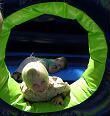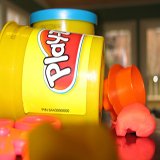Need Help with Baby Crawling?
You've come to the right place! Help with baby crawling is on its way! Follow the advice on these baby crawling pages and sit back and enjoy (or run around) as your baby becomes an expert crawler.
Baby Crawl Age?
Let me guess? You want to know at what age should your baby crawl? When baby crawl? This is the most frequently asked question on this site.
Well, I'm reluctant to mention time frames, but somewhere between six and ten months, it is expected that babies discover some way to move horizontally across the floor to get hold of desired objects. At around 8 months, they start getting up on their hands & knees or rocking backwards and forwards.
No timeframe can be linked as to how long your baby will be in the crawling stage. It all depends on how long they take to figure out that they can walk or at least stand on both feet.
 Help With Baby Crawling
Help With Baby CrawlingBaby not Crawling?
Baby crawling development isn't listed on typical charts of kids' development because it's not a developmental stage all kids go through. Crawling isn't mentioned in my favourite pediatric development textbook either! This seems strange since crawling is mostly associated with babies.
The truth is...
...some babies never crawl!
Need I say more? There is nothing to worry about. He might be one of those that skipped this phase and went from sitting straight to walking. He actually saved you a lot of washing!!
I have a Baby Crawling Backwards!
Some adults are concerned that a baby crawling backwards or children who don't crawl in the traditional way will be less coordinated. Well, let me clear things for you about your baby learning to crawl and baby fundamental movement skills in general. This is a myth!
Don't get upset because you want to get your baby crawling, but your baby is not following the norm.
It's ok that your crawling baby is going backwards. We should remember that all babies are different. You can't make a baby crawl; you can only try to promote the action. He'll do it when he's ready.
Baby Crawling on Tummy?
Crawling may be encouraged by spending time on the floor with your baby (called tummy time). Consider placing favourite toys just out of reach, putting a dog-bone pillow or a rolled towel under his chest when he's on his stomach. This will force him to keep his head up so he can look around and enjoy himself more when on his stomach. You can also put a hand behind his feet to give him something to push against if he tries to crawl.
Baby Exercises to Crawling
Physical exercises to teach baby to crawl involves lots of on-the-floor time. Sit on the floor with her all the time with toys and just hang out. If she is in the mood and she is on all fours ask your elder child to teach baby to crawl by showing her. Basically it's crawling baby exercises and they'll love it.
If they are on all fours in the crawling position, have one person facing her and the other behind her and teach baby to crawl by moving her arms and legs like she is baby crawling. Do it slowly and gently until she doesn't want to. My daughter LOVED it and giggled the entire time.
What are the Benefits of Baby Crawling?
Your baby feels his body in a different position, feeling the effects of gravity. He develops muscle strength and co-ordination of the muscles necessary for him to stay in this position. Baby crawling promotes the development of muscle strength in his neck and shoulders so he is able to lift his head easily. These are only some of the benefits of baby crawling.
Importance of Crawling
Studies have found that newly mobile infants show increased affection for their caregivers. Read more here on crawling benefits.
To help with baby crawling is indeed a wonderful experience for everyone. Follow the crawling tips and be there to support them all the way.
I hope you found the answer to your question here. If you didn't, please read through the other baby crawling pages or contact me. I'll be more than willing to research your question and provide to you more help with baby crawling.
So, please let me know if you need some other help with baby crawling not mentioned here.




